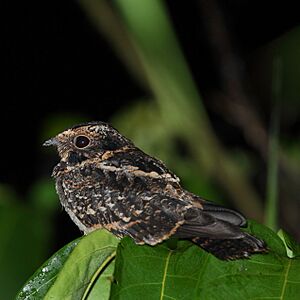Spot-tailed nightjar facts for kids
Quick facts for kids Spot-tailed nightjar |
|
|---|---|
 |
|
| Conservation status | |
| Scientific classification | |
| Genus: |
Hydropsalis
|
| Species: |
maculicaudus
|
 |
|
| Breeding Resident | |
| Synonyms | |
|
|
The spot-tailed nightjar (Hydropsalis maculicaudus) is a cool bird that belongs to the nightjar family. You can find it in places like Honduras, Mexico, Nicaragua, and many countries in South America. The only South American countries where it doesn't live are Chile and Uruguay.
Contents
About the Spot-tailed Nightjar
What's in a Name?
When this bird was first discovered, it was called Stenopsis maculicaudus. Later, it was moved into a different group called Caprimulgus. Scientists use DNA to figure out how animals are related. Now, they know for sure that the spot-tailed nightjar belongs to the Hydropsalis group. It's the only bird of its kind in this specific group.
How to Spot One: Description
The spot-tailed nightjar is about 20 to 21.5 centimeters (8 to 8.5 inches) long. That's about the length of a regular pencil! Male birds weigh around 28 to 35 grams (1 to 1.2 ounces), and females weigh 26 to 39 grams (0.9 to 1.4 ounces).
Their top feathers are brown, with darker spots on their head and lighter ones on their back. Their face is a mix of tawny (a brownish-orange) or reddish colors with dark brown speckles. They have a wide, buff-colored stripe above their eyes, like an eyebrow. A wide cinnamon-colored band goes around the back of their neck.
Their wings are mostly brown with tawny spots. The four outer tail feathers on each side are dark brown with tawny marks. They also have two or three big white spots. Only the males have white tips on these feathers, which can look a bit buff-colored. The inner tail feathers are a bit longer and are grayish-brown with brown speckles and stripes. Their chin, throat, and chest are cinnamon to buff, and their belly is buff-colored.
Where Do They Live? Distribution
The spot-tailed nightjar lives in many different places, but its populations are spread out.
- One group lives in southern Mexico.
- Another group is found in eastern Honduras and northern Nicaragua.
- In South America, one group lives in eastern Colombia and reaches into western Venezuela, Brazil, and a tiny bit of Ecuador.
- A second group stretches from eastern Venezuela through Guyana, Suriname, and French Guiana.
- A third group lives near the mouth of the Amazon River in northeastern Brazil.
- The biggest group lives from southeastern Peru across Bolivia, a large part of southern Brazil, and a little bit into Paraguay and Argentina.
These birds live at different heights depending on the country. In Mexico, they live in low areas up to 500 meters (1,600 feet) high. In Colombia, they go up to 400 meters (1,300 feet). In Venezuela, they can be found up to 1,000 meters (3,300 feet), and in Peru, up to 1,350 meters (4,400 feet).
Spot-tailed Nightjar Behavior
How They Move Around
The spot-tailed nightjars in South America usually stay in one place. But the ones in Central America are migratory, meaning they travel to different places during the year.
What and How They Eat: Feeding
The spot-tailed nightjar is a nocturnal bird, which means it's active at night. It hunts for food by swooping up from the ground or flying slowly and low to the ground. Its diet is made up entirely of insects. Scientists have seen it eating insects from at least 17 different groups!
Reproduction and Life Cycle
Scientists don't know everything about when these birds have their babies, but it seems to change a lot depending on where they live. They usually lay two eggs, but sometimes just one. They don't build a nest; they lay their eggs right on the ground!
What Sounds Do They Make? Vocalization
The spot-tailed nightjar's song sounds like a high, lisping tip-SEEEUUEEET. They sing this song from the ground or from a branch. They also have a fast t-seet t-seet t-seet t-seet call. When they are flying, they might make a slightly wailing seeeu or see-ee-eeii sound.
Spot-tailed Nightjar Status
The IUCN (International Union for Conservation of Nature) has looked at the spot-tailed nightjar and decided it is a species of "Least Concern." This means that it has a large area where it lives, and there are many of them. Its population is stable, and scientists don't see any immediate dangers to the species.


